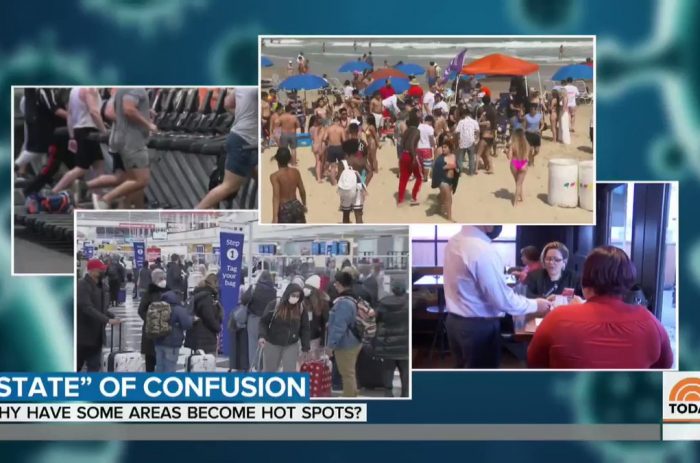redo Jump to...
print Print...
Directions
-Read the excerpt below (from John Hinderaker's Jan. 13 post at PowerLineBlog.com).
-Read "Types of Media Bias" in the right column. Then answer the questions.
From the PowerLineBlog.com post:
Crazed Veterans Spark Nationwide Crime Wave – That’s the theme of a front page article in [the Jan. 13] New York Times: “Across America, Deadly Echoes of Foreign Battles.” The article reports on what must have been a major effort by the Times to comb through news reports from across the country, identifying and tabulating instances where servicemen who returned from Iraq or Afghanistan were charged with some form of homicide. The Times summarizes the results of its research:
Town by town across the country, headlines have been telling similar stories. Lakewood, Wash.: “Family Blames Iraq After Son Kills Wife.†Pierre, S.D.: “Soldier Charged With Murder Testifies About Postwar Stress.†Colorado Springs: “Iraq War Vets Suspected in Two Slayings, Crime Ring.â€
Individually, these are stories of local crimes, gut-wrenching postscripts to the war for the military men, their victims and their communities. Taken together, they paint the patchwork picture of a quiet phenomenon, tracing a cross-country trail of death and heartbreak.
The New York Times found 121 cases in which veterans of Iraq and Afghanistan committed a killing in this country, or were charged with one, after their return from war.
The Times article goes on [for] nine pages long on the web–but it consists almost entirely of anecdotes about a handful of the 121 alleged crimes. The stories are indeed sad, and some of the soldiers and veterans involved no doubt did suffer from post-traumatic stress disorder. Still, the Times’ approach is astonishingly unsystematic, especially since the paper takes seriously the idea that the U.S. military may be responsible for the supposed crime wave:
At various times, the question of whether the military shares some blame for these killings gets posed.
When it is not recounting stories of crimes committed by servicemen, always from a point of view sympathetic to the idea that service in a theater of war was a contributing factor–“plagued by nightmares about an Iraqi civilian killed by his unit, [Mr. Sepi] often needed alcohol to fall asleep”–the paper waxes pretentious:
Decades of studies on the problems of Vietnam veterans have established links between combat trauma and higher rates of unemployment, homelessness, gun ownership, child abuse, domestic violence, substance abuse — and criminality. On a less scientific level, such links have long been known.
“The connection between war and crime is unfortunately very ancient,†said Dr. Shay, the V.A. psychiatrist and author. “The first thing that Odysseus did after he left Troy was to launch a pirate raid on Ismarus. Ending up in trouble with the law has always been a final common pathway for some portion of psychologically injured veterans.â€
Now put yourself in the place of a newspaper editor. Suppose you are asked to evaluate whether your paper should run a long article on a nationwide epidemic of murders committed by veterans of Iraq and Afghanistan–a crime wave that, your reporter suggests, constitutes a “cross-country trail of death and heartbreak.” Suppose that the reporter who proposes to write the article says it will be a searing indictment of the U.S. military’s inadequate attention to post-traumatic stress disorder. Suppose further that you are not a complete idiot.
Given that last assumption, I’m pretty sure your first question will be: “How does the murder rate among veterans of Iraq and Afghanistan compare to the murder rate for young American men generally?” Remarkably, this is a question the New York Times did not think to ask. Or, if the Times asked the question and figured out the answer, the paper preferred not to report it.
As of 2005, the homicide rate for Americans aged 18-24, the cohort into which most soldiers fall, was around 27 per 100,000. (The rate for men in that age range would be much higher, of course, since men commit around 88% of homicides. But since most soldiers are also men, I gave civilians the benefit of the doubt and considered gender a wash.)
Next we need to know how many servicemen have returned from Iraq or Afghanistan. A definitive number is no doubt available, but the only hard figure I’ve seen is that as of last October, more than 500,000 U.S. Army personnel had served in either Iraq or Afghanistan. Other sources peg the total number of personnel from all branches of the military who have served in the two theaters much higher, e.g. 750,000, 650,000 as of February 2007, or 1,280,000. For the sake of argument, let’s say that 700,000 soldiers, Marines, airmen and sailors have returned to the U.S. from service in Iraq or Afghanistan.
Do the math: the 121 alleged instances of homicide identified by the Times, out of a population of 700,000, works out to a rate of 17 per 100,000–quite a bit lower than the overall national rate of around 27.
But wait! The national rate of 27 homicides per 100,000 is an annual rate, whereas the Times’ 121 alleged crimes were committed over a period of six years. Which means that, as far as the Times’ research shows, the rate of homicides committed by military personnel who have returned from Iraq or Afghanistan is only a fraction of the homicide rate for other Americans aged 18 to 24. Somehow, the Times managed to publish nine pages of anecdotes about the violence wreaked by returning servicemen without ever mentioning this salient fact.
I’ve got a suggestion for the editors of the Times: next time, why don’t they undertake a research project to identify all murders and other forms of homicide committed (or allegedly committed–no finding of guilt necessary!) by people who are, or recently have been, employed by newspaper companies? They could write a long article in which selected crimes allegedly committed by reporters, editors and typesetters are recounted in detail, accompanied by speculation about whether newspaper employment was a contributing factor in each case. No need to wonder whether reporters, editors and typesetters commit homicide at a rate any different from the rest of the population–a single murder is too many!
Here’s another idea: the Times’ story on veterans’ crimes repeatedly focused on the role of alcoholism, which the paper associated with the stresses of military service. How about a survey that compares alcoholism rates among reporters and soldiers? Just on a hunch, I’ll wager a dollar that the alcoholism rate for reporters is higher.
……………….
Go to PowerLineBlog.com for the original posting.
To accurately identify different types of bias, you should be aware of the issues of the day, and the liberal and conservative perspectives on each issue.
Types of Media Bias:Questions
1. Explain how the NY Times article referred to could be an example of bias by OMISSION.
2. Do you think that the NY Times’ report discussed below is biased against U.S. military veterans, or an honest attempt to portray a serious problem with the Iraq war? Explain your answer.
3. Ask a parent to read the excerpt below and answer the same question.
Scroll down to the bottom of the page for the answers.
Answers
1. The NY Times article referred to could be an example of bias by OMISSION because it does not answer the question: “How does the murder rate among veterans of Iraq and Afghanistan compare to the murder rate for young American men in general?”
2. and 3. OPINION QUESTIONS. Answers vary.



